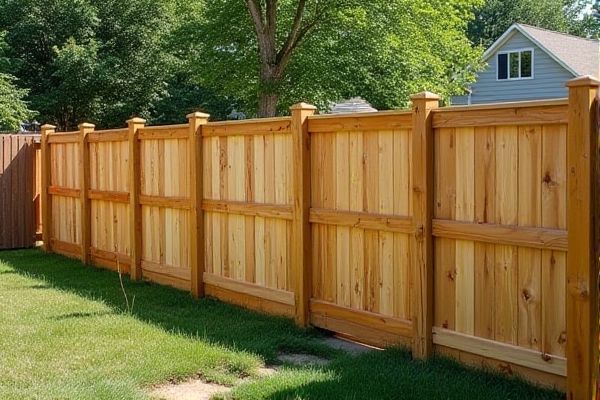
Natural wood fences offer a classic, rustic aesthetic with customizable stains and a warm, organic feel, while vinyl fences provide durable, low-maintenance, and weather-resistant options that resist fading and warping. Explore the rest of the article to determine which fence type best suits your needs and enhances your property's appeal.
Table of Comparison
| Feature | Natural Wood Fence | Vinyl Fence |
|---|---|---|
| Material | Natural wood (cedar, pine, redwood) | PVC (polyvinyl chloride) |
| Durability | 5-15 years (subject to weather, rot, insects) | 20-30 years (resistant to rot, insects, weather) |
| Maintenance | Requires regular staining, sealing, or painting | Low maintenance; occasional cleaning with soap and water |
| Cost | Moderate initial cost; higher long-term maintenance costs | Higher initial cost; lower maintenance expenses |
| Appearance | Natural, classic wood grain look | Uniform color; available in various styles and colors |
| Environmental Impact | Biodegradable; sourced from renewable timber | Non-biodegradable; made from synthetic materials |
| Installation | Requires professional or DIY with proper tools | Easy to install with snap-together panels |
| Weather Resistance | Prone to warping, cracking in extreme climates | Highly resistant to UV rays, moisture, and temperature changes |
Overview: Natural Wood Fence vs Vinyl Fence
Natural wood fences offer a classic, rustic aesthetic with customizable designs and natural durability, requiring regular maintenance such as staining and sealing to prevent weather damage. Vinyl fences provide a low-maintenance alternative, resisting rot, insects, and fading while offering consistent color and design options, ideal for long-term durability. Cost differences vary, with wood typically lower initial investment but higher upkeep, whereas vinyl demands higher upfront expense offset by reduced maintenance costs.
Material Composition and Sourcing
Natural wood fences are crafted from sustainable timber such as cedar, pine, or redwood, sourced from responsibly managed forests that emphasize renewable harvesting practices. Vinyl fences consist of polyvinyl chloride (PVC), a synthetic plastic polymer derived from fossil fuels, offering low maintenance and weather-resistant properties but with less environmental biodegradability. Choosing between these materials impacts your fence's ecological footprint, durability, and aesthetic appeal based on the origin and composition of each material.
Aesthetic Appeal and Customization Options
Natural wood fences provide a warm, classic aesthetic with the ability to stain or paint in various colors, complementing diverse architectural styles and landscaping designs. Vinyl fences offer a clean, uniform look that mimics wood grain while requiring minimal maintenance and resisting weathering, fading, and insects. Customization options for wood include intricate carvings and varied panel styles, whereas vinyl fencing allows modular designs and color finishes that maintain their appearance over time.
Durability and Longevity Comparison
Natural wood fences offer a classic aesthetic but are susceptible to rot, insect damage, and weathering, typically lasting 10 to 15 years with proper maintenance. Vinyl fences provide superior durability, resisting moisture, insects, and UV damage, often lasting 20 to 30 years with minimal upkeep. Your choice impacts long-term investment and maintenance efforts, with vinyl delivering enhanced longevity and resilience compared to natural wood.
Maintenance Requirements
Natural wood fences require regular maintenance, including staining or painting every 2-3 years to prevent rot, insect damage, and weathering. Vinyl fences offer a low-maintenance alternative, needing only occasional cleaning with soap and water to maintain their appearance and resist fading. Choosing vinyl reduces long-term upkeep costs and effort, providing a durable and weather-resistant option for Your property.
Environmental Impact and Sustainability
Natural wood fences offer a lower environmental footprint due to their biodegradability and renewable sourcing from sustainably managed forests, reducing plastic waste and chemical pollutants. Vinyl fences, while durable and low-maintenance, rely on petroleum-based materials and release toxic chemicals during production and disposal, impacting ecosystems negatively. Choosing sustainably harvested wood supports carbon sequestration and habitat preservation, making it a more eco-friendly fencing option.
Cost Analysis: Initial and Long-Term Expenses
Natural wood fences typically incur lower initial costs, averaging between $15 to $30 per linear foot, but require regular maintenance such as staining and sealing, leading to higher long-term expenses. Vinyl fences, with initial costs ranging from $20 to $40 per linear foot, offer greater durability and minimal upkeep, resulting in lower maintenance expenses over time. Evaluating total cost of ownership favors vinyl for longevity and minimal repair, while wood remains cost-effective upfront but demands ongoing investment.
Installation Process and Considerations
Natural wood fences require precise measuring, cutting, and nailing, often demanding basic carpentry skills and more installation time. Vinyl fences feature interlocking panels and pre-made posts that simplify and speed up the installation, often enabling DIY-friendly setups. Your choice should consider time, skill level, and potential maintenance linked to the installation process.
Weather Resistance and Performance
Natural wood fences offer a classic aesthetic but are more susceptible to weather damage, including warping, rotting, and insect infestation, requiring regular maintenance such as sealing and staining to prolong lifespan. Vinyl fences provide superior weather resistance, being impervious to moisture, insects, and UV rays, maintaining their appearance and structural integrity with minimal upkeep even in harsh climates. Vinyl's durability and low maintenance make it a cost-effective long-term solution for consistent performance against rain, snow, and sun exposure.
Which Fence is Right for Your Property?
Choosing between a natural wood fence and a vinyl fence depends on your priorities for aesthetics, maintenance, and budget. Natural wood fences offer a classic, rustic charm and are customizable with paint or stain but require regular upkeep to prevent rot and insect damage. Vinyl fences provide long-lasting durability with minimal maintenance and resistance to weather and pests, making them ideal for homeowners seeking a low-maintenance solution for their property.
 homyna.com
homyna.com